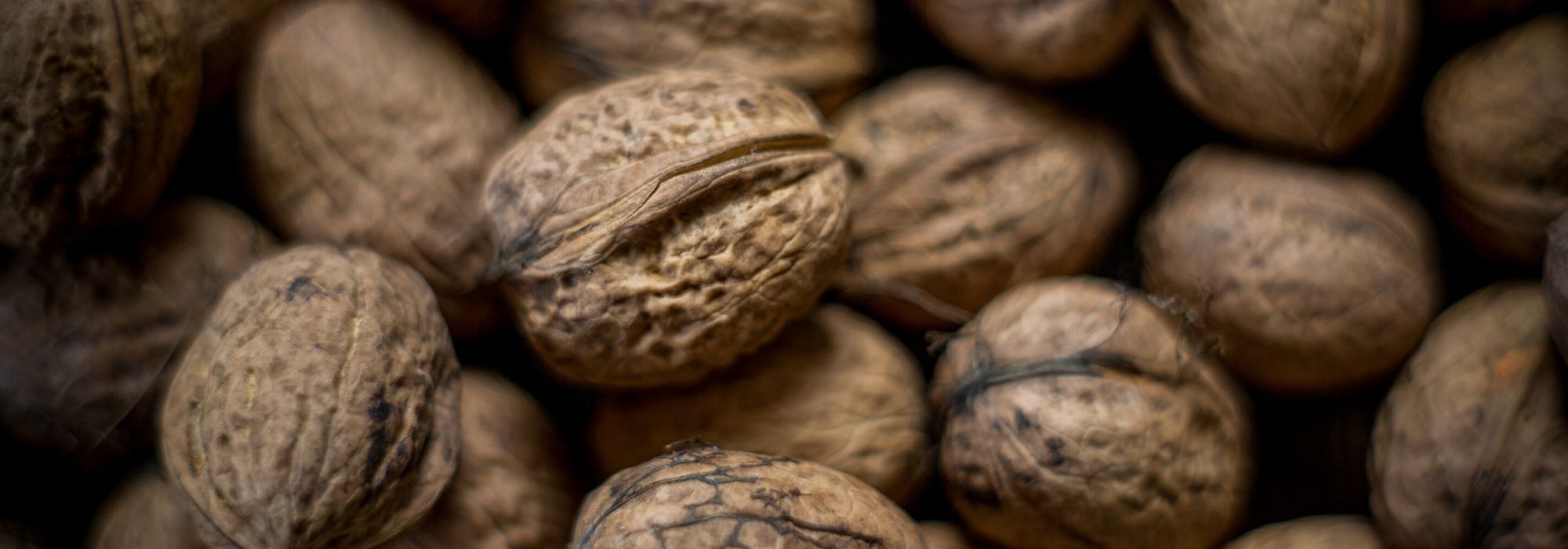
Walnut, Juglans regia: planting, pruning and care
Contents
Walnut, in a nutshell
- Walnut forms a stocky tree about 15 m tall and is long-lived.
- It bears large compound leaves and produces nuts, walnuts, rich in oil and excellent for health.
- Very hardy, walnut grows in a cool climate on calcareous to neutral soil in a sunny position.
- Plant 2 varieties to obtain a better harvest, suited to your region.
A word from our expert
Common walnut, Juglans regia, is a medium-sized tree, easy to grow at back of a fairly large garden. Its shade is quite dense and its leaves should not be put in compost. But apart from that, it is a magnificent tree, planted to last, which only yields its walnuts after 10 to 20 years, contained in a burr in autumn and able to be stored for over a year. There are nearly 15 species of walnut worldwide that all produce edible walnuts, although species regia provides most varieties consumed in France such as Franquette.
These dried fruits, rich in omega-3, are recommended for prevention of heart attacks and strokes with a consumption of only 2 to 3 walnuts per day. Besides their content of fats, fibre and protein, they contain minerals and vitamins including vitamin E, recognised as a very powerful antioxidant to combat cell deterioration. They also reduce risk of type 2 diabetes and help prevent colorectal cancer in women.
The walnut belongs to family Juglandaceae and is native to south-eastern Europe and temperate Asia. It requires permanently moist soil and thrives in fertile, alluvial soils of light texture. In lowland areas, choose late varieties less sensitive to spring frosts that affect young shoots.
It forms a robust trunk topped by a compact crown. Its dark wood, renowned for its hardness, fine grain and dark colour, together with its burls, are used in cabinetmaking. Leaves are pubescent and bear 7 to 9 leaflets, dark green and almost ovate, turning yellow in autumn.
Description and botany
Botanical data
- Latin name Juglans regia
- Family Juglandaceae
- Common name Common walnut, English walnut
- Flowering between April and June
- Height between 15 and 30 m
- Exposure sun or partial shade
- Soil type any loose, well-drained soil, even calcareous
- Hardiness Excellent (-25 °C)
Genus Juglans belongs to family Juglandaceae and includes about twenty species, native to south-east Europe, eastern Asia, northern India and North and South America. Common walnut, also called English walnut, Juglans regia, source of main cultivated varieties in France is native to a vast area stretching from south-east Europe to China. It is cultivated both for its walnuts and its high-quality wood.
English walnut is a large tree with a deep root system that withstands severe cold (-30 °C) since it occurs naturally on Himalayan foothills. However, it does not like overly hot situations such as Mediterranean south and its young shoots are sensitive to spring frosts common in valleys. Choose in that case a late variety such as Franquette or Parisienne.
Its stocky outline gives impression of a robust tree with strong branches, 15 to 20 m high with a 9 to 18 m spread. Growth is relatively slow as tree reaches 10 m after 20 years. Good rich soil composed of alluvial deposits, fresh, calcareous and well drained allows it to live for more than 200 years.
The young bronze-purple leaves become bright green at ripeness before yellowing in autumn. The alternate leaves, borne on a petiole of 3–4 cm, comprise 5 to 9 pointed leaflets with an ovate base, the terminal leaflet being more developed.
Flowering is clearly visible in spring – between April and June depending on variety – in the form of yellow-green male aments measuring 5 to 10 cm long in a lateral position along the shoots.
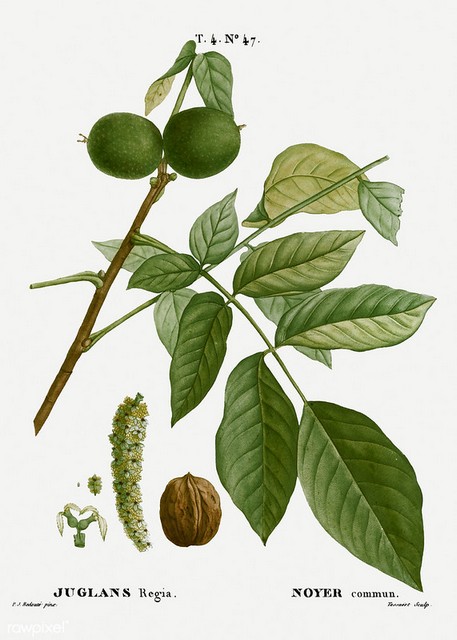
Juglans regia – botanical illustration by P.J. Redouté
The female flowers, rather inconspicuous, appear at the tips in groups of 3 or 4. This tree needs a long establishment period to start producing walnuts, between 15 and 25 years, but there are fast-producing varieties such as Franquette which flower after 5 to 7 years. Production is fairly variable from year to year but can continue until age 70. It is advisable to plant another variety nearby to encourage fertilization of the flowers because male aments do not mature at the same time as the female flowers.
The spherical fruit 4–5 cm in diameter has a fleshy, smooth green husk, very staining to the touch, called brou which encloses the stone corresponding to the walnut protected by its beige shell. The fruit opens in autumn to release the seed whose shell, more or less hard, is formed of two hemispheres with a sinuous surface. The cracked walnut reveals two whitish kernels covered with a thin beige skin slightly bitter when walnut is fresh, which suggest the hemispheres of a brain. They are eaten fresh or dried, grated or pressed for oil production.
The black walnut (Juglans nigra) is also valued for its nut and the quality of its wood. It has the advantage of resisting armillaria root rot.
According to the doctrine of signatures, very popular in the Middle Ages, nature would give keys to knowledge by its physical appearance. People thus imagined, rightly, that eating walnuts benefited the brain by referring to the seed’s appearance in two sinuous hemispheres.

Walnut: male ament, female flower, foliage and fruit, walnut
Main walnut varieties
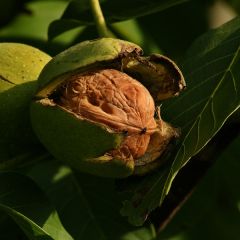
Common Walnut Franquette - Juglans regia
- Flowering time June
- Height at maturity 10 m
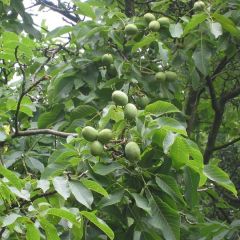
Common Walnut Parisienne - Juglans regia
- Flowering time June
- Height at maturity 10 m
Discover other Walnut trees
View all →Available in 2 sizes
Available in 2 sizes
Available in 2 sizes
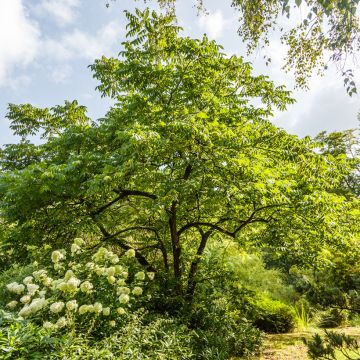
Available in 1 sizes
Available in 2 sizes
Available in 1 sizes
Available in 1 sizes
Available in 1 sizes
Available in 1 sizes
Available in 1 sizes
Planting
Where to plant walnut?
Plant walnut in isolation, in very sunny, not too windy position, in deep, fairly loose soil so it can extend its roots even if it tolerates clay.
Walnut dislikes both stagnant moisture and prolonged drought. Provide fresh, deep, well-drained soil, even calcareous. Despite excellent hardiness (-25°C), an overly cold winter limits fruiting and can weaken the tree. Its sensitivity to late frosts means that a walnut will not develop properly north of the Loire whereas it grows well up to 1,000 m altitude in southern France. Drôme, Isère and Périgord are main French production regions for walnut.
When to plant?
Prefer autumn (October–November) to plant walnut trees, or March–April.
How to plant?
This plant is easy to grow but bear in mind that nothing grows under its foliage because it produces juglone, a compound aromatic toxic to most plants. Its shade is dense. People say you mustn’t fall asleep under a walnut, or you’ll catch a cold!
Allow spacing of 8–10 m between each walnut.
- Dig a spacious planting pit at least three times the width of the rootball.
- Submerge pot in a bucket of water to soak it thoroughly.
- Add a few shovelfuls of sand and gravel to ensure good drainage around roots, and some compost to lighten soil. On very acidic soil (pH below 6.5), add dolomite or ash.
- Place a stake at a distance from the rootball.
- Place the plant in the planting hole, avoiding burying the collar.
- Replace soil and firm down lightly.
- Tie the trunk of the walnut to its stake without overtightening.
- Water then mulch.

Care
- During the first few years, water your walnut during periods of severe drought.
- Apply compost or organic fertiliser in autumn or spring under the crown. After three years, once your walnut is well established, it requires little care.
- Shape your tree by selecting three or four main scaffold branches when the desired height is reached to give a goblet habit. You can also let it grow taller if there is sufficient distance between the walnut and the house. In that case, keep the leading shoot and then gradually raise the lower branches.
- Minimise pruning of your walnut; only remove dead wood and crossing branches when they are of small diameter.
Walnut harvest and storage
The husk splits open on the tree and drops the walnuts to the ground between September and November depending on the earliness of the variety. Use a pole to shake the branches and speed their fall if necessary.
Keep walnuts that are not blackened and show no wormholes.
You can eat them fresh or dry them on racks by laying them in a single layer in a cool, dry and well‑ventilated place.
Almost half of a walnut’s moisture evaporates, allowing storage for 1–2 years without problem.
Green walnuts can also be harvested in June, on St John’s Day, for making walnut wine.
→ Learn more in Solenne’s tutorial: Harvesting and storing walnuts
Propagation
Sowing in spring is the easiest way to propagate walnut trees unless you want to grow specific varieties, in which case layering by stooling or grafting onto a seed-grown walnut is recommended.
Sowing a walnut
- Harvest walnuts in autumn,
- Remove husks (wear gloves to avoid staining hands).
- Stratify them in sand in a pot placed facing north, covered with 15 cm of sand.
- Place a wire mesh over the pot to stop rodents getting at them.
- Walnuts that have produced a radicle, usually around March, are then planted out in open ground at their final position in groups of three or placed in a deep pot filled with garden soil.
- Bury them in situ in groups of three, 5 cm deep, spacing groups 8 to 10 m apart.
- Select the most vigorous of the three seedlings the following autumn. You can graft a variety after one year by a cleft graft performed at the start of the following spring.
- Take scions about 1 cm in diameter in winter and insert them into sand placed facing north.
- When sap rises, cut back the rootstock stem and split it to insert a scion shoot, cut with a double bevel, into the cleft.
- Tie the graft with damp raffia and seal with grafting wax.
Grafted young plants reach ripeness faster than young plants grown from sowing.
Uses and associations
Few plants will grow under walnut trees, but you can plant it against a backdrop of country hedgerow composed of European spindle, cornelian cherry, laurustinus and other plants for calcareous soil if your soil is alkaline. Space walnut trees at least 8 to 10 m apart if planting several. Let branches develop naturally or train to an open-centre form to harvest walnuts more easily.
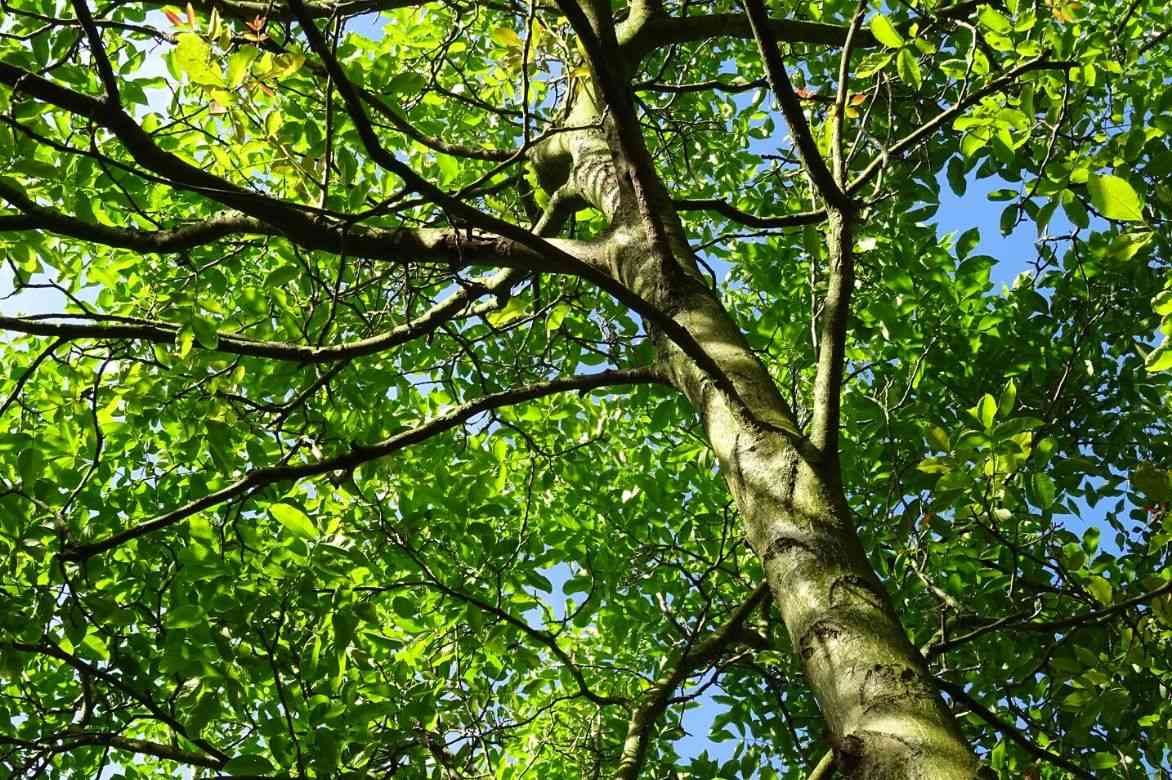
Learn more
Discover our range of Walnut trees
Find out more about diseases and parasitic pests of the walnut tree in our care sheet
Discover our care sheet on Pecan tree: how to grow it to harvest pecans
Discover our care sheets: To grow nuts in the garden and Walnut tree: how to choose the right variety?
Wondering what to plant under a walnut tree? Answers are here!
- Subscribe!
- Contents



































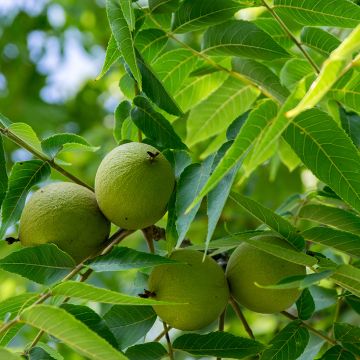
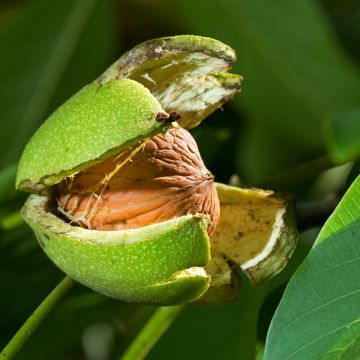
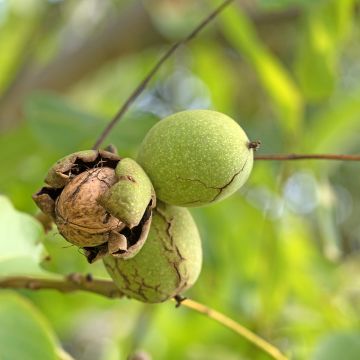
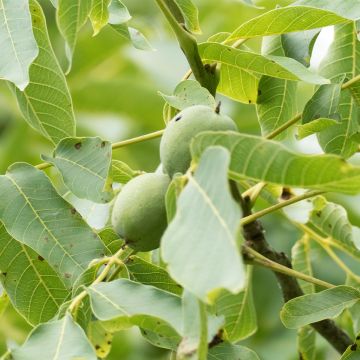
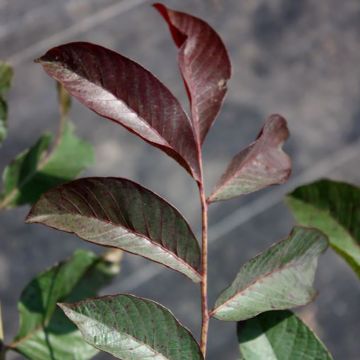
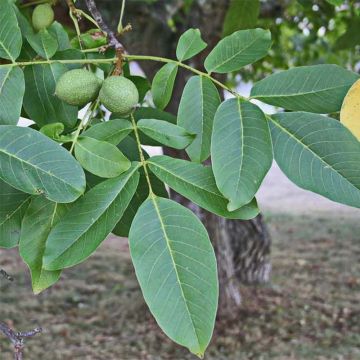
Comments